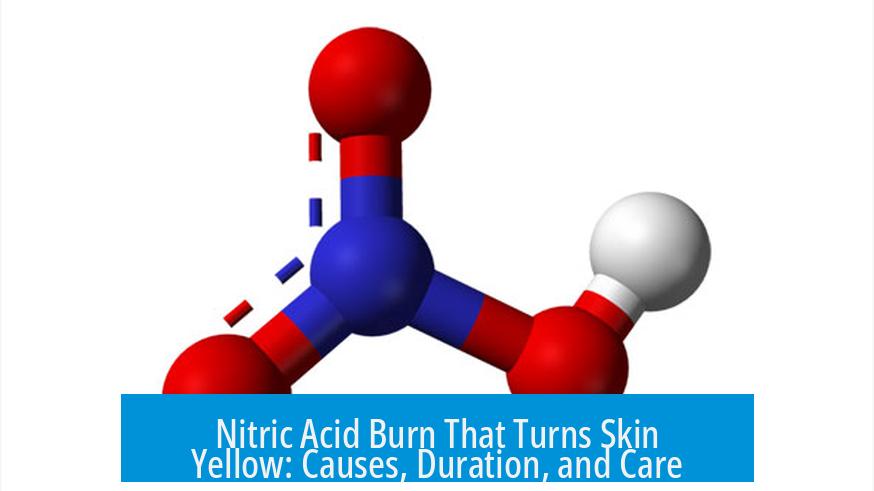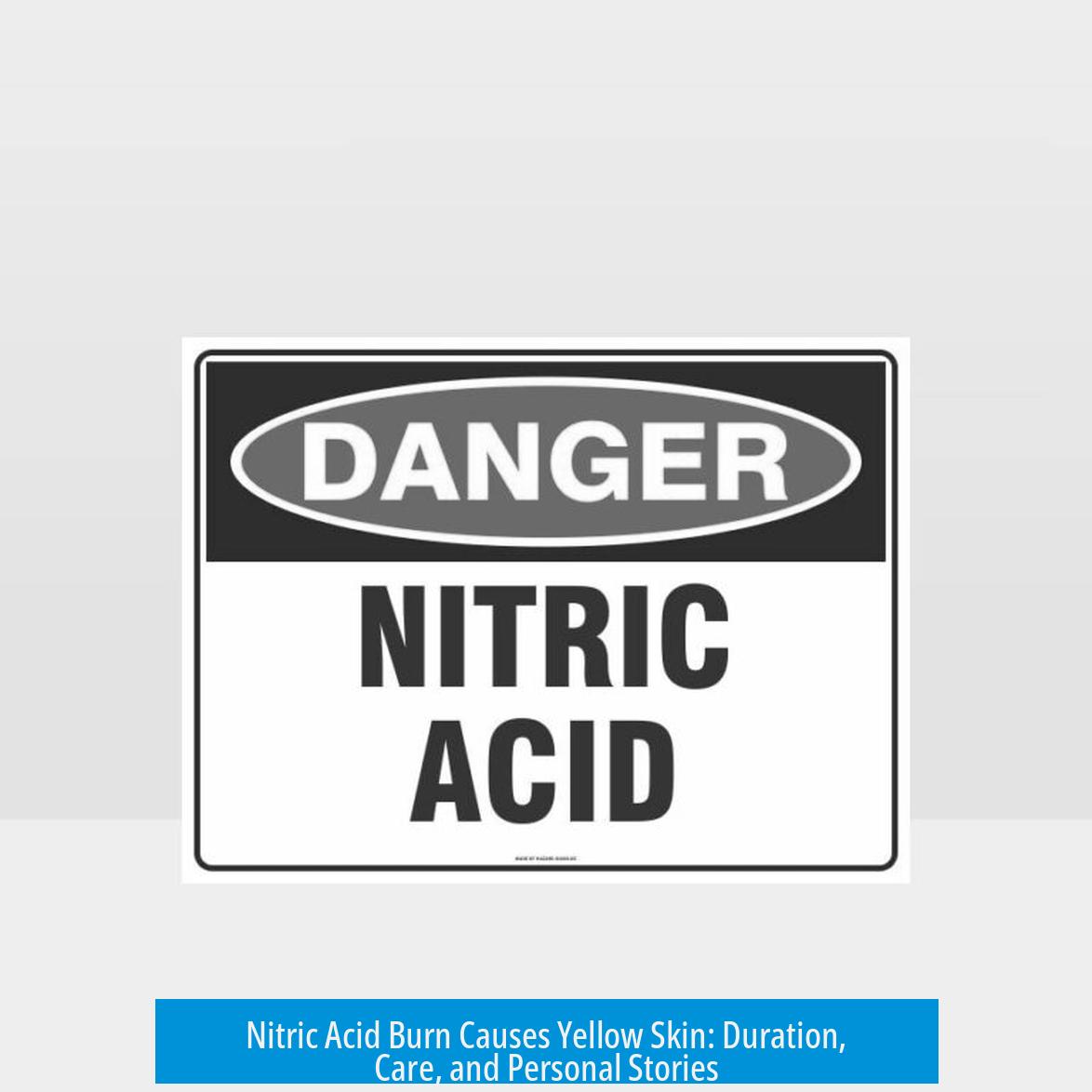Nitric Acid Burn That Turns Skin Yellow: Causes, Duration, and Care

A nitric acid burn that turns the skin yellow results from a chemical reaction creating nitrotyrosine in skin proteins, causing a yellow discoloration that can last for several weeks until the affected skin peels off naturally.
Understanding the Yellow Discoloration
The striking yellow color seen after a nitric acid burn comes from a chemical called nitrotyrosine. This compound forms when nitric acid reacts with the amino acid tyrosine in the skin’s proteins.
- Nitric acid nitrates tyrosine residues in skin proteins, creating this persistent yellow stain.
- This reaction gives rise to a distinctive “NO2 patch” visible on the skin.
- The stain’s appearance often resembles nicotine stains on fingers, but results solely from chemical interaction with the skin.
The initial contact with nitric acid leads to these chemical modifications rather than simple surface discoloration, which explains why the yellow stain cannot be quickly wiped off.
Duration of the Yellow Stain and the Healing Process

The yellow patch formed due to nitric acid burns usually lasts between several days to a few weeks. Various experiences from those affected show some variability:
- Many report the stain lasting around one month until the affected skin fully peels off.
- Others describe discoloration persisting for up to two months, especially when nails are involved.
- Some cases have shown resolution in as little as 4 to 5 days.
Peeling of the dead skin is the natural endpoint of the healing process, much like healing from a sunburn.
- The yellowed area typically becomes hard and crust-like before sloughing off as the skin regenerates.
- This peeling process may cause mild itching or discomfort but rarely involves significant pain.
- Scratching gently at the edge of peeling skin can help the dead tissue shed, but premature peeling should be avoided to prevent irritation or infection.
Physical Sensations and Symptoms
The physical effect of a nitric acid burn varies depending on concentration and exposure. Common sensations include:
- A brief but intense burning or “furnace-like” sensation upon contact.
- Subsequent dryness and itching of the affected area.
- The formation of dry, scab-like patches resembling a glue film.
Interestingly, some individuals experience minimal pain despite the noticeable chemical damage and discoloration. The primary discomfort tends to come from skin tightness and itching during healing.
Personal Accounts of Nitric Acid Burns
Several chemists and laboratory workers share stories confirming the persistent yellow stain as a recognizable “mark of the chemist.” Experiences include:
- Burns covering large areas like a whole palm, with discoloration lasting a month or more until full skin regeneration.
- Single drops causing localized yellow stripes or spots, sometimes fading more quickly.
- Dead skin removal occurring naturally or being carefully peeled off after prolonged yellow staining.
- In some cases, permanent scarring can result from deeper or more severe burns.
Such burns are so common in chemistry labs that they are considered a kind of “rite of passage” among practitioners.
Safety and Prevention: Protecting Skin from Nitric Acid
The best approach to avoid nitric acid burns is prevention through personal protective equipment (PPE). Key recommendations:
- Always wear nitrile or other acid-resistant gloves when handling nitric acid.
- Use protective clothing such as lab coats and long sleeves to reduce skin exposure.
- Work in a well-ventilated area or fume hood to avoid inhalation of harmful NO2 fumes.
- Quickly rinse any spills or splashes from skin with copious water to limit chemical reaction time.
Even experienced chemists acknowledge occasional lapses leading to burns, emphasizing constant vigilance and PPE use.
Comparison to Other Chemical Burns
Nitric acid burns differ in appearance and healing compared to burns from other acids and bases:
| Chemical | Appearance | Duration | Healing Notes |
|---|---|---|---|
| Nitric Acid (HNO3) | Yellow discoloration (Nitrotyrosine) | Days to Weeks (up to 2 months) | Peeling of yellowed skin; mild itching; often minimal pain |
| Sulfuric Acid (H2SO4) | Brown/black dehydrated areas | Variable, often longer | Feels like intense burning; can cause deeper tissue damage |
| Potassium Hydroxide (KOH) | Grayish, dry patches | Weeks | Intense itching and pain typical; corrosive burn |
| Hydrochloric Acid (HCl) | Black spots | Variable | Can cause surface burns; often less staining than HNO3 |
Nitric acid’s unique yellow stain results from chemical nitration, setting it apart from burns caused by acids or bases purely destroying tissue.
Handling Symptoms and Long-Term Outlook
Typically, a nitric acid burn does not result in permanent damage if treated early. Key points to consider:
- Immediate flushing with water reduces severity.
- The yellow stain is cosmetic and temporary, fading as the skin naturally regenerates.
- Itching can be managed with gentle moisturizing and avoiding irritants.
- Consulting a healthcare professional is advised if burns are severe, painful, or show signs of infection.
- Scarring is rare but possible in severe cases, especially if peeling skin is forcibly removed.
Cultural and Community Perspectives
Among chemists, nitric acid burns carry a cultural significance. They are viewed as almost a badge of experience in the lab:
- Many jokes and anecdotes celebrate the characteristic yellow stains as a “chemistry rite of passage.”
- Some laboratories see it as a common misadventure, with tales passed down between generations of students.
- Popular media and shows have referenced nitric acid burns as a recognizable sign of chemical mishaps.
This shared experience fosters a sense of camaraderie, despite the discomfort involved.
Summary of Key Points
- The yellow discoloration is caused by nitrotyrosine formed when nitric acid nitrates skin proteins.
- Discoloration can last from a few days up to several weeks, fading as dead skin peels off.
- Symptoms include mild itching and dryness, often with minimal pain.
- Wearing proper PPE reduces risk; immediate washing after exposure aids healing.
- Nitric acid burns differ visibly and chemically from other acid or base burns.
- Scarring is rare but can occur in severe burns.
- Cultural references in the chemistry community regard these burns as a common learning experience.
What causes the yellow discoloration on the skin from a nitric acid burn?
The yellow tint comes from nitrotyrosine. This forms when nitric acid reacts with tyrosine in your skin proteins. It creates a NO2 patch that looks like a nicotine stain on your skin.
How long does the yellow discoloration from a nitric acid burn usually last?
The color can last from a few days up to several weeks. Typically, the yellow skin peels off like a sunburn within 1 to 4 weeks, but sometimes it stays longer depending on the burn’s severity.
Does the yellowed skin from the burn cause any discomfort?
It may itch as the skin dies and prepares to peel. The sensation can be quite irritating, but pain is usually mild or absent once the initial burn is over.
What is the healing process after a nitric acid burn that stains the skin yellow?
The affected skin hardens, forms a scab-like texture, and eventually flakes off. The peeling can take weeks. Some people experience itching during this time, and the new skin underneath reveals normal tone.
Can nitric acid burns leave permanent marks or scars?
Severe burns might leave scars. Mild burns typically resolve without lasting marks after the yellow layer sheds. Still, some users report scars from deeper skin damage.
Are there any differences between nitric acid burns and burns from other acids?
Nitric acid causes yellow staining due to nitration, unlike other acids that might cause redness or black spots. Healing times and symptoms can vary depending on the acid strength and exposure duration.





Leave a Comment